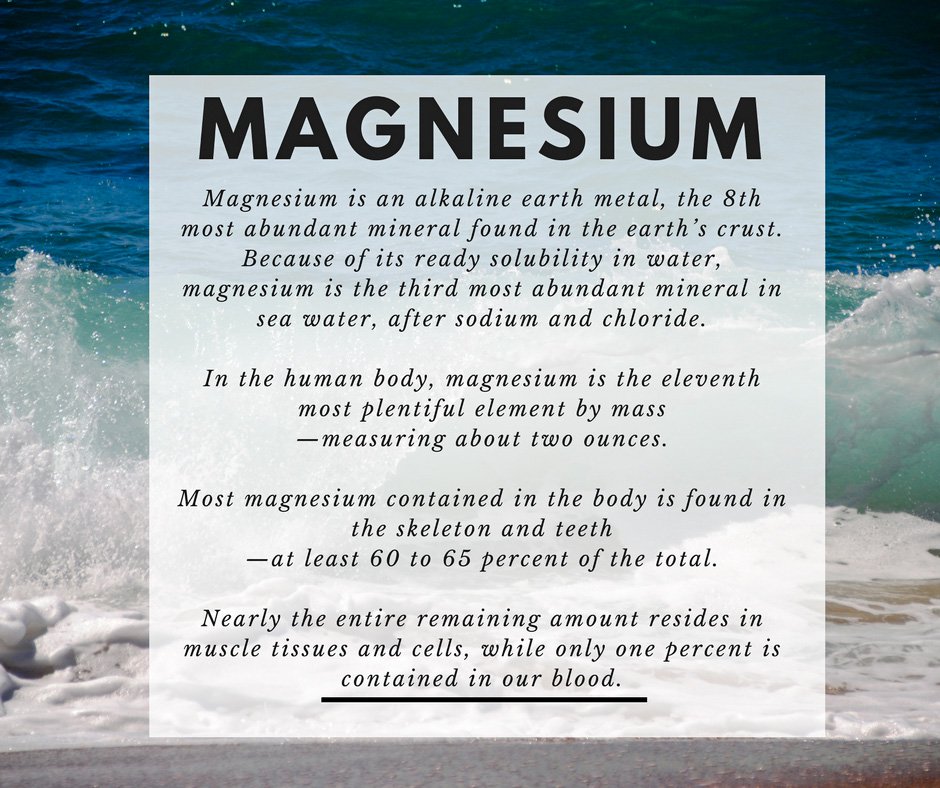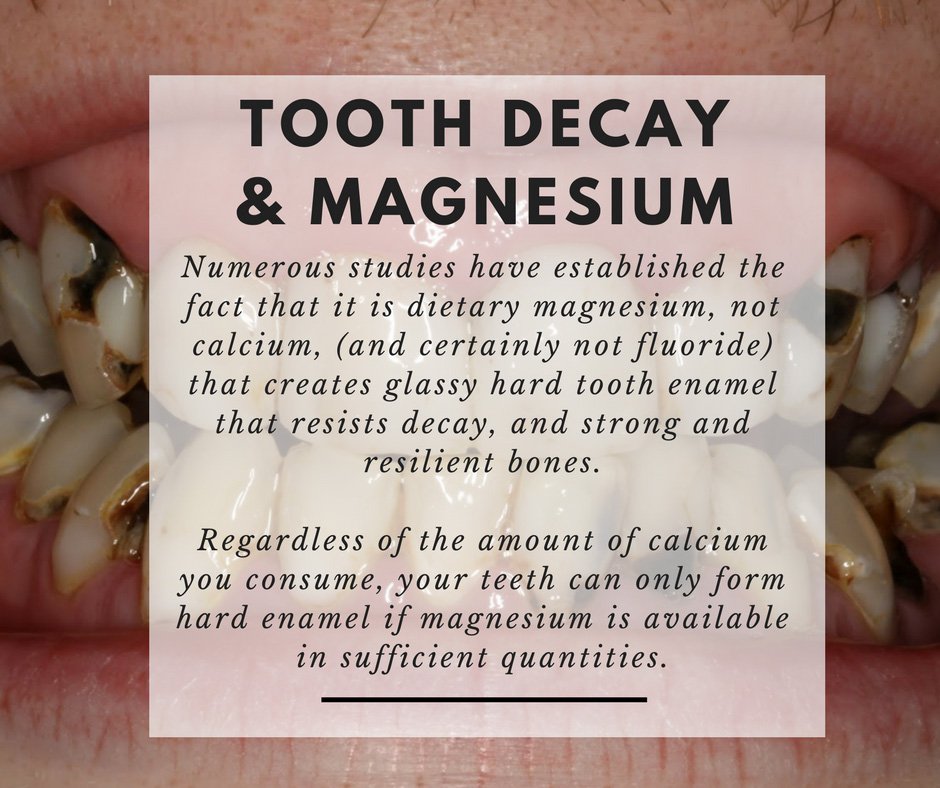The Neglected Mineral We Cannot Live Without

Every single cell in the human body demands adequate magnesium to function, or it will perish. Magnesium is so important to so many vital body functions, and its deficiency is integrally involved in so many diseases, that more than one researcher has dubbed magnesium a miracle in its ability to resolve or improve numerous disorders. Unfortunately, it is difficult to reliably supply our bodies with sufficient magnesium, even from a good, balanced whole foods diet. Even with organic foods, a magnesium deficient soil creates magnesium deficient crops.
Magnesium and other nutrients are diminished or lost in produce after harvest, through handling, refrigeration, transport and storage, even if all these steps were done “properly.” Buying produce and then storing it for days in your own refrigerator continues the nutrient loss, whether the produce is from the supermarket or your local farmers’ market.

The importance of magnesium ions for all life itself, as well as for overall vibrant health, is hard to overstate. Magnesium is required to give the “spark of life” to metabolic functions involving the creation of energy and its transport (ATP, the body’s fundamental energy currency), and the creation of proteins—the nucleic acid chemistry of life—RNA and DNA, in all known living organisms. In plants, a magnesium ion is found at the center of every chlorophyll molecule, vital for the creation of energy from sunlight. Magnesium is an essential element for both animals and plants, involved in literally hundreds of enzymatic reactions affecting virtually all aspects of life.
Every single cell in the human body demands adequate magnesium to function, or it will perish. Strong bones and teeth, balanced hormones, a healthy nervous and cardiovascular system, well-functioning detoxification pathways and much more depend upon cellular magnesium sufficiency. Soft tissue containing the highest concentrations of magnesium in the body include the brain and the heart—two organs that produce a large amount of electrical activity, and which can be especially vulnerable to magnesium insufficiency.
Magnesium works in concert with calcium to regulate electrical impulses in the cell—magnesium concentration inside healthy cells is ten thousand times greater than calcium, and there are crucial reasons for this safeguard. Cellular calcium channels allow that mineral to enter the cell only as long as needed to conduct an impulse; it is ushered out immediately by magnesium once its task is fulfilled. This vigilance is necessary to prevent calcium accumulation in the cell, which could cause dangerous hyper-excitability, calcification, cell dysfunction and even cell death. When excess calcium enters the cells because of insufficient magnesium, muscle contraction is sustained for too long, and we suffer, for example, twitches and tics in mild cases. When magnesium deficiency becomes chronic, we suffer the symptoms of heart disease such as angina pectoris, hypertension and arrhythmia, or the spasms and contractions characteristic of asthma, migraine headache or painful menstrual cramping.
Magnesium operates as a natural calcium channel blocker and is responsible for relaxation—counter to calcium’s contraction. Thus magnesium is pivotally important to the healthy functioning of our parasympathetic nervous system. It may be hard to believe, but our bodies were actually designed to operate for the most part in a calm, relaxed parasympathetic state, rather than in the heart-pounding, stress- and adrenaline-driven mode of sympathetic nervous system dominance that is nearly constant for many of us today, and which uses up great quantities of magnesium.
Magnesium is so important to so many vital body functions, and its deficiency is integrally involved in so many diseases, that more than one researcher has dubbed magnesium a miracle in its ability to resolve or improve numerous disorders. The current list of disorders with direct and confirmed relationships to chronic and acute magnesium deficiency is long, and includes many diseases whose conventional medical treatment does not commonly address magnesium insufficiency (see below). Ongoing research promises to uncover further associations between magnesium deficiency and other illnesses.
MAGNESIUM DEFICIENCY IS WIDESPREAD
Unfortunately, it is difficult to reliably supply our bodies with sufficient magnesium, even from a good, balanced whole foods diet. First of all, modern agricultural methods favor the universal use of NPK fertilizers (nitrogen, phosphorus, and potassium). Both potassium and phosphorus are antagonists of magnesium in the soil, and on calcareous soils create a relative magnesium deficiency (the magnesium present is bound and therefore unavailable to the crop). On sandy or loamy soils that are slightly acid, an actual magnesium deficiency often exists, as the magnesium leaches from the soil and is also unavailable to the crop. This leaching also occurs in response to acid rain. Magnesium, in fact, is one of the most depleted minerals in farm soils. To add insult to injury, new plant hybrids are continually introduced that have been bred to survive on these mineral-depleted soils. Of course, when mineral-depleted crops are eaten by animals or by us, they will sooner or later cause disease. Even though organically raised crops should be a better bet nutritionally, this isn’t always the case, and it pays in terms of your health to learn how your farmer replenishes the minerals on his fields.
“Do you know that most of us today are suffering from certain dangerous diet deficiencies which cannot be remedied until depleted soils from which our food comes are brought back into proper mineral balance? The alarming fact is that foods (fruits, vegetables, grains) now being raised on millions of acres of land that no longer contain enough of certain minerals are starving us—no matter how much of them we eat. The truth is that our foods vary enormously in value, and some of them aren’t worth eating as food.” These words of warning are from the 74th Congress, 2nd session, Senate document number 264, of 1936. It is truly sobering to learn that the decline in soil mineral balance was a topic of serious national concern more than seventy years ago, and the deficit has been affecting us—while steadily getting worse— since our grandparents’ generation.
Magnesium and other nutrients are diminished or lost in produce after harvest, through handling, refrigeration, transport and storage, even if all these steps were done “properly.” Buying produce and then storing it for days in your own refrigerator continues the nutrient loss, whether the produce is from the supermarket or your local farmers’ market.
Food processing causes enormous loss of magnesium in foods that are commonly fairly good sources of it, such as leafy greens, nuts, seeds and whole grains. Most of the magnesium in grain— found in the bran and germ—is lost in milling whole grains for white flour, which is used nearly exclusively for hundreds of devitalized processed food items. When nuts and seeds are roasted or their oils extracted, magnesium is lost. Cooking greens causes whatever magnesium they might contain to leach into the cooking water. Foods tend to lose less calcium than magnesium through these processes, adding to a troublesome dietary calcium overload that we will discuss shortly.
Fluoride in drinking water binds with magnesium, creating a nearly insoluble mineral compound that ends up deposited in the bones, where its brittleness increases the risk of fractures. Water, in fact, could be an excellent source of magnesium—if it comes from deep wells that have magnesium at their source, or from mineral-rich glacial runoff. Urban sources of drinking water are usually from surface water, such as rivers and streams, which are low in magnesium. Even many bottled mineral waters are quite low in magnesium, or have a very high concentration of calcium, or both.
A diet of processed, synthetic foods, high sugar content, alcohol and soda drinks all “waste” magnesium, as a lot of it is required for the metabolism and detoxification of these largely fake foods. According to Dr. Natasha Campbell-McBride, the body requires at least twenty-eight molecules of magnesium to metabolize a single molecule of glucose. Phosphates in carbonated drinks and processed meats (so-called “luncheon meats” and hot dogs) bind with magnesium to create the insoluble magnesium phosphate, which is unusable by the body.
Tannins, oxalates, and phytic acid all bind with magnesium, making it unavailable to the body unless extra care is taken to neutralize some of these compounds during food preparation. It is interesting to note that foods commonly containing magnesium (provided they were grown in mineral-rich soil) also contain lots of these anti-nutrients, such as spinach (oxalates) and whole grains (phytates).
Many commonly prescribed pharmaceutical drugs cause the body to lose magnesium via the urine, such as diuretics for hypertension; birth control pills; insulin; digitalis; tetracycline and some other antibiotics; and corticosteroids and bronchodilators for asthma. With the loss of magnesium, all of the symptoms being “treated” by these drugs over time inevitably become worse.
Magnesium absorption is impeded with the use of supplemental iron. If you take calcium supplements, your need for magnesium increases, and in fact calcium will not be properly absorbed or metabolized if adequate magnesium is missing, and will mostly end up dangerously deposited in soft tissues. Magnesium is responsible for converting vitamin D to the active form that allows calcium to be absorbed, and also regulates calcium’s transport to hard tissues where it belongs. Lactose is another inhibitor of magnesium absorption (and milk is not a good source of the mineral to begin with), along with excess potassium, phosphorus and sodium.
Mental and physical stress, with its related continuous flow of adrenaline, uses up magnesium rapidly, as adrenaline affects heart rate, blood pressure, vascular constriction and muscle contraction— actions that all demand steady supplies of magnesium for smooth function. The nervous system depends upon sufficient magnesium for its calming effects, including restful sleep. Hibernating animals, by the way, maintain very high levels of magnesium. Magnesium deficiency will accelerate a vicious cycle and amplify the effects of chronic stress, leading to more anxiety, irritability, fatigue and insomnia—many of the symptoms of adrenal exhaustion—as well as to hypertension and heart pains—symptoms of heart disease.
Depression is related to stress and magnesium deficiency as well. Serotonin, the “feel good” hormone, requires magnesium in its delicate balance of release and reception by cells in the brain. Only when adequate levels are present can we enjoy mental and emotional equilibrium.
For reasons not fully understood, the body does not retain magnesium very well; certainly not as well as it holds onto calcium or iron, for example. Heavy sweating from endurance sports such as marathon running or strenuous exercise workouts can dangerously deplete magnesium stores and other electrolytes—although calcium is not wasted, by the way— resulting in trembling, faintness and even seizures and death. The drenching sweats that some menopausal women suffer cause magnesium loss as well, and their diminishing magnesium levels worsen their jagged nerves, sleep disturbances, panic attacks, body aches and depression. If these women have been tempted to consume modern soy products in a misguided attempt to moderate their symptoms, they will in fact lose even more magnesium because it will be bound to the abundant phytates in these concoctions.
A healthy gut environment is necessary for proper absorption of magnesium from the diet. Irritable bowel syndrome, leaky gut, candidiasis and other gut disorders can severely limit the amount of magnesium that the body will be able to absorb. Older adults often experience decreased stomach hydrochloric acid production, which can impair mineral absorption in general. And with so many treating their “heartburn” with antacids, a healthy digestive environment is hard to maintain.
CALCIUM AND MAGNESIUM PARTNERSHIP
Both calcium and magnesium are necessary for the healthy body—in proper balance to one another, as well as to other necessary minerals. Considered biochemical antagonists, one cannot act without eliciting the opposite reaction of the other. Yet calcium and magnesium must both be present in balanced amounts for either one to function normally in the body. Some researchers suggest that the healthy ratio of calcium to magnesium in the diet should be 2:1. Others consider 1:1 to reflect ratios that we evolved with based on our diet prior to the advent of agriculture. In modern industrialized countries the ratio from diet is from 5:1 to as much as 15:1. The imbalance of these two very important minerals produces many dire consequences in the body that are often overlooked by medical practitioners when treating the disease states they cause.
Aside from the intricate electrical dance that calcium and magnesium perform together, magnesium is necessary to keep calcium in solution in the body, preventing its inappropriate deposition in soft tissues. As long as we have sufficient hydrochloric acid in our stomachs we can dissolve calcium from the foods we eat. After calcium leaves the acidic environment of the stomach and enters the alkaline milieu of the small intestine however, it is magnesium that is necessary to keep calcium soluble. Without sufficient magnesium, a whole host of physiological aberrations can occur with serious health consequences.
As Dr. Carolyn Dean, author of The Magnesium Miracle, explains, “In the large intestine it [precipitated calcium] interferes with peristalsis, which results in constipation. When calcium precipitates out in the kidneys and combines with phosphorus or oxalic acid, kidney stones are formed. Calcium can deposit in the lining of the bladder and prevent it from fully relaxing, and therefore from filling completely with urine. This leads to frequent urination problems, especially in older people. Calcium can precipitate out of the blood and deposit in the lining of the arteries, causing hardening (arteriosclerosis). . . It can coat and stiffen. . . plaque in the arteries. . . [and] can cause blood pressure to rise as well as increase the risk of heart attack and stroke. Calcium can even deposit in the brain. Many researchers are investigating it as a possible cause of dementia, Alzheimer’s and Parkinson’s disease. Calcium can deposit in the lining of the bronchial tubes and cause asthma symptoms. Calcium in extracellular fluid. . . can decrease the permeability of cell membranes. This makes it increasingly difficult for glucose (a large molecule) to pass through the cell membrane to be converted to ATP in the cells’ mitochondria. High glucose levels created by excess calcium may be misdiagnosed as diabetes.”
MAGNESIUM IS A POTENT DETOXIFIER
Magnesium is utilized by the body for all sorts of detoxification pathways and is necessary for the neutralization of toxins, overly acidic conditions that arise in the body, and for protection from heavy metals. It plays a vital role in protecting us from the onslaught of man-made chemicals all around us. Glutathione, an antioxidant normally produced by the body and a detoxifier of mercury, lead and arsenic among others, requires magnesium for its synthesis. According to Mark Sircus, in Transdermal Magnesium Therapy, a deficiency of magnesium increases free radical generation in the body and “causes glutathione loss, which is not affordable because glutathione helps to defend the body against damage from cigarette smoking, exposure to radiation, cancer chemotherapy, and toxins such as alcohol and just about everything else.”
When our bodies are replete with magnesium (and in balance with the other essential minerals) we are protected from heavy metal deposition and the development of associated neurological diseases. As Dr. Carolyn Dean explains, “Research indicates that ample magnesium will protect brain cells from the damaging effects of aluminum, beryllium, cadmium, lead, mercury and nickel. We also know that low levels of brain magnesium contribute to the deposition of heavy metals in the brain that heralds Parkinson’s and Alzheimer’s. It appears that the metals compete with magnesium for entry into the brain cells. If magnesium is low, metals gain access much more readily.
“There is also competition in the small intestine for absorption of minerals. If there is enough magnesium, aluminum won’t be absorbed.”
MAGNESIUM DEFICIENCY IN TOOTH DECAY AND OSTEOPOROSIS
Ask anyone—your neighbor or even your dentist or doctor—what bones and teeth require to be strong and healthy, and you will undoubtedly hear the response, “Plenty of calcium.” Bones and teeth certainly do require calcium—as well as phosphorus and magnesium, but without adequate amounts of the latter, calcium will not be deposited in these hard tissues, and the structures will not be sound. “When you load up your system with excess calcium,” writes William Quesnell, in Minerals: the Essential Link to Health, “you shut down magnesium’s ability to activate thyrocalcitonin, a hormone that under normal circumstances would send calcium to your bones.” Instead of providing benefits to the body, the displaced calcium actually becomes toxic, causing trouble in soft tissues of the kinds we’ve already discussed.

According to J. I. Rodale, in Magnesium: the Nutrient that Could Change Your Life, “For years it was believed that high intakes of calcium and phosphorus inhibited decay by strengthening the enamel. Recent evidence, however, indicates that an increase in these two elements is useless unless we increase our magnesium intake at the same time. It has even been observed that dental structures beneath the surface can dissolve when additional amounts of calcium and phosphorus diffuse through the enamel at different rates. Thus milk, poor in magnesium, but high in the other two elements, not only interferes with magnesium metabolism, but also antagonizes the mineral responsible for decay prevention.”
To revisit Deaf Smith County, Texas, and the justly famous residents whose teeth refused to succumb to decay, Rodale quotes the observations of Dr. Lewis Barnett, presented in a paper before the Texas Medical Association in Dallas, 1952. Dr. Barnett, an orthopedic surgeon, remarked on the low incidence of tooth decay and rapid healing of broken bones among these residents, and offered this explanation: “[The local] water and foods have a very high magnesium and iodine content and recently we have proven that all of the trace minerals known to be essential are present in the water and foods grown in that area.” Further, Dr. Barnett had found that the magnesium bone content of the average Deaf Smith County resident was up to five times higher than that of a resident of Dallas, while the concentrations of calcium and phosphorus were about the same in both groups. His observations led him to state that “[o]ne of the most important aspects of the disease osteoporosis has been almost totally overlooked. That aspect is the role played by magnesium.”
Rodale emphasizes the fact that Dr. Barnett gave much of the credit for these health benefits to the high magnesium content of the local water, and noted many signs of superior bone development among people in the area: “Dr. Barnett makes mention of the fact that people in older years frequently have fracture of the cervical neck of the femur and these are very difficult to heal in many localities. However, he noted that this fracture rarely occurs in Deaf Smith County, whereas it was common in Dallas County, Texas, where he also practiced. When a fracture did occur in Deaf Smith, healing was easy and rapid even in people eighty to one hundred years old. In contrast, fractures in Dallas were common and very difficult to heal, if not impossible.”
Over fifty years ago Dr. Barnett tested the magnesium levels of five thousand people and found sixty percent of them to be deficient. How much more of the population is deficient today, when all of the negative conditions contributing to that deficiency have been certainly amplified?
FOOD SOURCES OF MAGNESIUM
As we’ve mentioned, if farm soils are well-mineralized, leafy green vegetables, seeds, tree nuts and whole grains are fairly good sources of magnesium. Certain wild-crafted forage foods really stand out, however, such as nettles (860 mg per 100 grams) and chickweed (529 mg per 100 grams), and add many tonic and nutritive benefits to both human and livestock diets largely due to their high mineral content. Kelp, ancient denizen of the sea, contains spectacular levels, as do most sea vegetables. Remember that they are continually bathed in a solution whose third most abundant mineral is magnesium. And authentic, unrefined sea salt is a very good source of magnesium, along with trace minerals. Utilizing bone broths on a daily basis will provide another excellent source of minerals, including magnesium, in a highly assimilable form.

-and more includes:
• Osteoporosis
• Parkinson’s disease
• PMS—including menstrual pain and irregularities
• PPH (Primary pulmonary hypertension)
• Reynaud’s syndrome
• SIDS (Sudden Infant Death Syndrome)
• Stroke
• Syndrome X
• Thyroid disorders
Source: Primal Body—Primal Mind, by Nora Gedgaudas.
FOOD SOURCES OF MAGNESIUM
In milligrams per 100 grams
Kelp 760 Pecan 142 Beets 25 Wheat bran 490 Walnut 131 Broccoli 24 Wheat germ 336 Rye 115 Cauliflower 24 Almonds 270 Tofu curdled by Mg nigiri 111 Carrot 23 Cashews 267 Coconut meat, dried 90 Celery 22 Blackstrap molasses 258 Collard greens 57 Beef 21 Nutritional yeast 231 Shrimp 51 Asparagus 20 Buckwheat 229 Corn, sweet 48 Chicken 19 Brazil nuts 225 Avocado 45 Green pepper 18 Dulse 220 Cheddar cheese 45 Winter squash 17 Filberts 184 Parsley 41 Cantaloupe 16 Peanuts 175 Prunes 40 Eggplant 16 Millet 162 Sunflower seeds 38 Tomato 14 Wheat whole grain 160 Sweet potato 31 Milk 13
MAGNESIUM SUPPLEMENTATION CAN BE TRICKY
learn more here…https://www.westonaprice.org/health-topics/abcs-of-nutrition/magnificent-magnesium/#.WfD8Hf5BIQU.facebook
REFERENCES
The Magnesium Miracle, by Carolyn Dean, M.D., N.D., Ballantine Books, 2007.
Transdermal Magnesium Therapy, by Mark Sircus, Ac., O.M.D., Phaelos Books, 2007.
Magnesium Therapy, by Patricia Ann Braun, M.D. http:// pbraunmd.org/magnesium.htm.
Magnesium: The Nutrient that Could Change Your Life, by J.I. Rodale http://www.mgwater.com/rod06.shtml.
Leaky gut and magnesium deficiency: http://magnesiumforlife.com/medical-application/magnesium-and-autism/.
The dangers of magnesium deficiency in endurance athletes: http://findarticles.com/p/articles/mi_m0FDL/is_4_14/ai_n24940334/.
Primal Body-Primal Mind, by Nora Gedgaudas, Primal Body-Primal Mind Publishing, 2009.
Healing Wise: Wise Woman Herbal, by Susun S. Weed, Ash Tree Publishing, 1989.
Put Your Heart in Your Mouth, by Dr. Natasha Campbell- McBride, Medinform, 2007.






